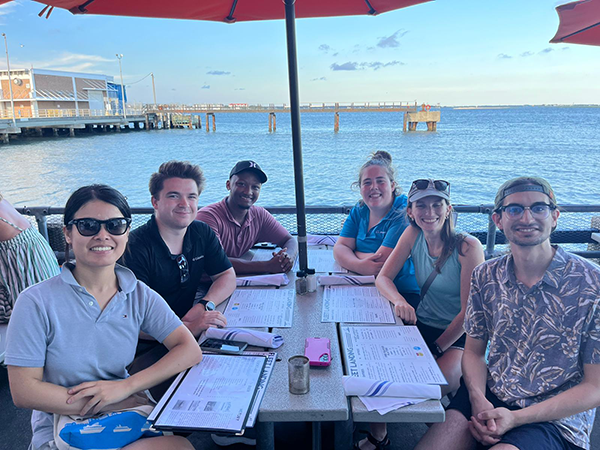Controlling the course of contrails
Han Ding is working to make aviation more sustainable through a high-resolution weather model.
Aviation accounts for 10 percent of U.S. transportation greenhouse gas (GHG) emissions and roughly three percent of the nation’s total GHG production, including carbon dioxide (CO2). But the effects of airplane travel on the environment extend to more than just CO2. These non-CO2 effects known as contrails—the long, white streaks behind airplanes in the sky—have historically received far less attention than decarbonization efforts. But Han Ding is hoping to change that.
Ding, a mechanical engineering graduate student in Hamish Gordon’s group, has worked as an intern at Boeing for the past two summers. As a member of Boeing’s Graduate Researcher Program (GRP), Ding contributed to advanced modeling and sustainable aviation research, including the development of high-resolution weather simulation workflows for contrail forecasting and mitigation. Her work supported Boeing’s efforts to reduce aviation’s environmental impacts while building cross-functional bridges between research, data engineering, and real-world applications in the global aviation industry.

Contrails (also known as condensation trails) form when hot, moist exhaust from aircraft engines mixes with the cold, ambient air at cruising altitudes, typically about 20,000–30,000 feet. When the air is cold enough, typically below minus 40 degrees Celsius, water vapor condenses on small soot and sulfate particles from engines to form supercooled liquid droplets, which rapidly freeze into ice crystals and form line-shaped ice clouds.
While contrails don’t occur for every flight, since they depend on specific temperature and humidity atmospheric conditions, they are still harmful to the environment. Most contrails disappear quickly, but those that persist in the sky can form artificial cirrus clouds, trapping warm air and creating a net warming effect on the climate, especially at night.
To help better understand contrails and reduce their formation, Ding uses a high-resolution weather model to simulate atmospheric conditions along flight routes at an altitude where a commercial airplane would fly. Factors like temperature and relative humidity are crucial to the model’s accuracy of predicting when and where persistent contrails are most likely to form. Understanding the physics behind contrail formation is the first step of an “avoidance strategy” to reduce aviation’s environmental impact, said Ding.
“If we can predict where contrails are likely to form based on both atmospheric conditions and aircraft-specific parameters, air traffic control could reroute flights to avoid these regions,” Ding said. “Such contrail avoidance strategies require integrating weather forecasts with engine emission characteristics and flight trajectory optimization to minimize climate impact.”
The second step in reducing contrail formation involves sustainable aviation fuel (SAF), which has been shown to emit significantly fewer soot particles than traditional jet fuel, thereby leading to a reduction in the initial number of ice crystals in contrails. To study the effect of SAF on contrail formation, NASA and Boeing partnered in 2023 to conduct a contrail research campaign—an initiative that advances the two organizations’ mutual goal of making aviation more sustainable and environmentally friendly.
As part of her internship, Ding helped analyze the data from this initiative and will be listed as a co-author on an upcoming paper, expected to be published in early 2026.
Being the only intern on her team at Boeing, Ding said she feels “lucky and proud to be sitting alongside colleagues who have more than 20 years of experience in this field while still in school.” Her Ph.D. work and expertise in atmospheric modeling were crucial to her success as one of the first interns in Boeing’s GRP.
The ability to predict the future climate is a powerful feeling and motivates me to pursue this work.
Han Ding, graduate student, Mechanical Engineering
“To predict future climate, especially by the end of the century, we cannot directly measure what has not yet occurred,” Ding said. “Instead, we rely on physics-based climate models, which are evaluated against past and present observations to simulate plausible scenarios. The ability to predict the future climate is a powerful feeling and motivates me to pursue this work.”
Moving forward, Ding envisions a career in industry and has ambitions of becoming a chief sustainability officer, a relatively new leadership position many companies are now launching.
“I feel super proud of the experience and lessons I have learned at Boeing,” Ding said. “Being an international student, I never imagined something like working at Boeing would be possible. I am always looking for more opportunities to grow.”
